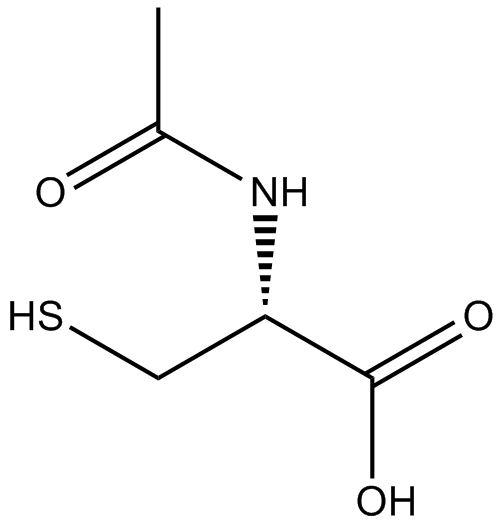Acetylcysteine (Synonyms: N-acetylcysteine; N-acetyl-L-cysteine; NAC; Acetadote) |
| Catalog No.GC11786 |
Acetylcysteine is the N-acetyl derivative of CYSTEINE.
Products are for research use only. Not for human use. We do not sell to patients.

Cas No.: 616-91-1
Sample solution is provided at 25 µL, 10mM.
Acetylcysteine is the N-acetyl derivative of CYSTEINE. NAC (N-acetyl-L-cysteine) is commonly used to identify and test ROS (reactive oxygen species) inducers, and to inhibit ROS.Acetylcysteine (N-Acetylcysteine) is a mucolytic agent which reduces the thickness of the mucus[1]. It has also been shown to have antiviral effects in patients with HIV due to inhibition of viral stimulation by reactive oxygen intermediates. Acetylcysteine also has anti-influenza virus activities[5].
Millimolar concentrations of Acetylcysteine potentiated markedly the inhibitory effect of nitroglycerin on platelet aggregation induced by ADP, epinephrine, collagen, and arachidonate, decreasing the 50% inhibitory concentration (IC50) approximately 50-fold for each of these agents.In the absence of Acetylcysteine, nitroglycerin induced a marked decrease in platelet-reduced glutathione content as S-nitroso-thiol adducts were produced. The synthetic S-nitroso-thiol, S-nitroso-N-acetylcysteine, markedly inhibited platelet aggregation with an IC50 of 6 nM[7].Acetylcysteine increased ERK-1 activity in PC12 cells after 15 min of treatment and maximal stimulatory activity for 60 min. We also observed that Acetylcysteine caused tyrosine phosphorylation of ERK-1 in cells treated with this compound for 30 min[4].Acetylcysteine induces cell apoptosis. When used serum-deprived PC12 cells, neuronally differentiated PC12 cells deprived of serum and NGF, and NGF-deprived neonatal sympathetic neurons. In each case L-Acetylcysteine prevents apoptotic DNA fragmentation and maintains long-term survival in the absence of other trophic support[3].Acetylcysteine prevents hemin-induced ferroptosis by neutralizing toxic lipids generated by arachidonate-dependent activity of 5-lipoxygenases[2].
In mice, Acetylcysteine exerts a significant protective role in liver injury following IIR, which seems to be independent of an intestinal protective effect. Additional administration of Acetylcysteine before reperfusion was of no further benefit. The most effective regimen among the compared regimens was that of 300 mg/kg before ischemia[6].
References:
[1]: Halasi M, Wang M, et,al. ROS inhibitor N-acetyl-L-cysteine antagonizes the activity of proteasome inhibitors. Biochem J. 2013 Sep 1;454(2):201-8. doi: 10.1042/BJ20130282. PMID: 23772801; PMCID: PMC4322432.
[2]: Farr SA, Poon HF, et,al. The antioxidants alpha-lipoic acid and N-acetylcysteine reverse memory impairment and brain oxidative stress in aged SAMP8 mice. J Neurochem. 2003 Mar;84(5):1173-83. doi: 10.1046/j.1471-4159.2003.01580.x. PMID: 12603840.
[3]: Ferrari G, Yan CY, et,al. N-acetylcysteine (D-and L-stereoisomers) prevents apoptotic death of neuronal cells. J Neurosci. 1995 Apr;15(4):2857-66. doi: 10.1523/JNEUROSCI.15-04-02857.1995. PMID: 7722634; PMCID: PMC6577755.
[4]: Yan CY, Greene LA. Prevention of PC12 cell death by N-acetylcysteine requires activation of the Ras pathway. J Neurosci. 1998 Jun 1;18(11):4042-9. doi: 10.1523/JNEUROSCI.18-11-04042.1998. PMID: 9592085; PMCID: PMC6792807.
[5]: Garigliany MM, Desmecht DJ. N-acetylcysteine lacks universal inhibitory activity against influenza A viruses. J Negat Results Biomed. 2011 May 9;10:5. doi: 10.1186/1477-5751-10-5. PMID: 21554703; PMCID: PMC3104374.
[6]: Kalimeris K, Briassoulis P, et,al. N-acetylcysteine ameliorates liver injury in a rat model of intestinal ischemia reperfusion. J Surg Res. 2016 Dec;206(2):263-272. doi: 10.1016/j.jss.2016.08.049. Epub 2016 Aug 19. PMID: 27884318.
[7]: Loscalzo J. N-Acetylcysteine potentiates inhibition of platelet aggregation by nitroglycerin. J Clin Invest. 1985 Aug;76(2):703-8. doi: 10.1172/JCI112024. PMID: 2863286; PMCID: PMC423881.
Average Rating: 5 (Based on Reviews and 26 reference(s) in Google Scholar.)
GLPBIO products are for RESEARCH USE ONLY. Please make sure your review or question is research based.
Required fields are marked with *




